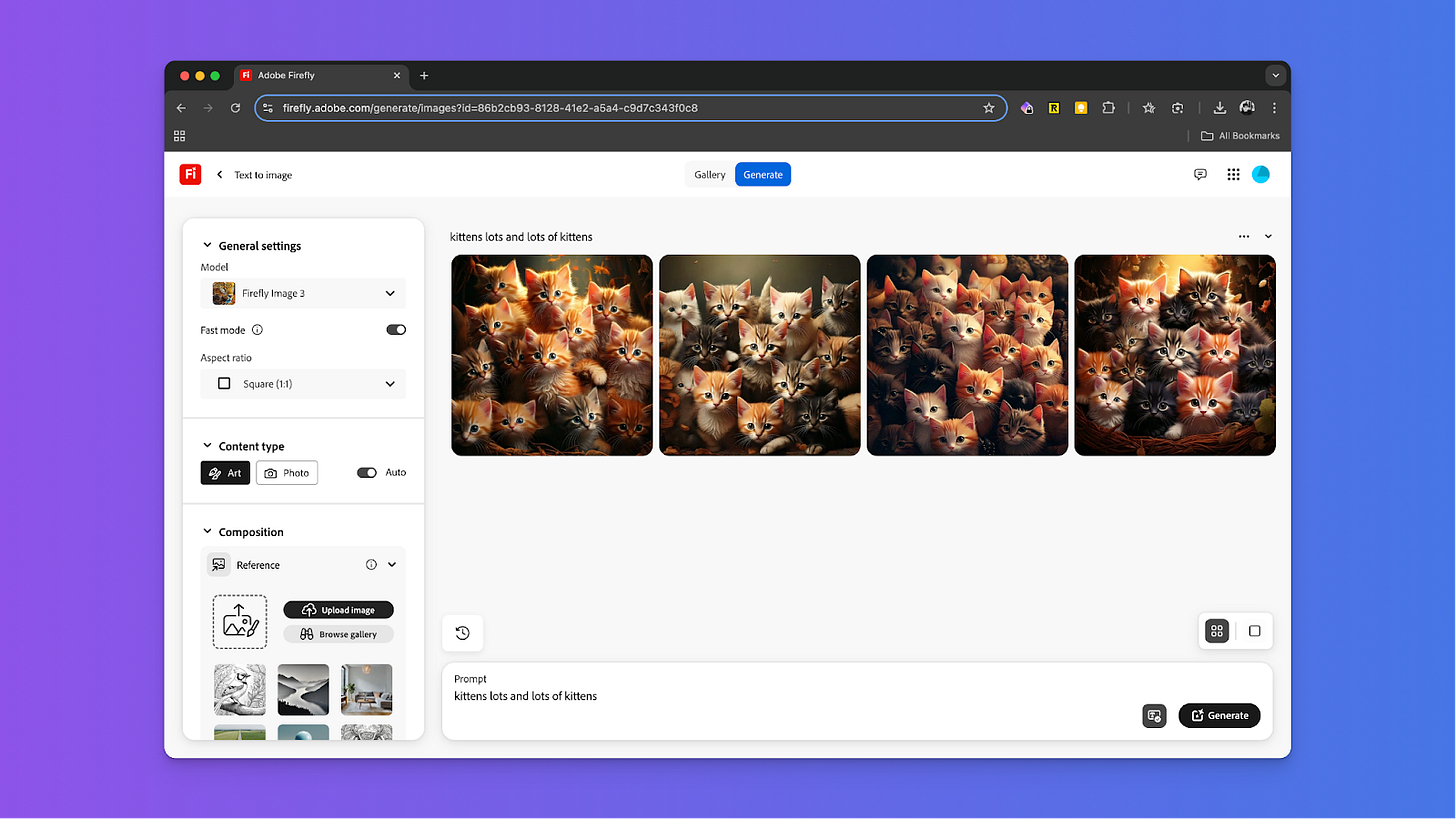Generative Variability: Infinite Possibilities in AI Product Design
From Predictable Software to Dynamic Creative Partners
Summary: Generative AI is transforming software, moving from predictable tools to creative playgrounds. By offering diverse outputs, it empowers users with choice, but risks overwhelming them. Effective design curates options, provides customization, and prioritizes user collaboration and transparency.
The Shift from Predictable to Playful
Last week, I was trying to pick out a birthday card for my niece. Not just any card, something with personality. A card that screamed 'cool uncle who gets her.' I spent what felt like a lifetime sifting through the same tired cliches: kittens with yarn, puppies with floppy ears, rainbows and glitter explosions. My frustration grew. Where was the card that captured her love for skateboarding and her obsession with Harry Potter? Where was the card that said, 'I see you, you tiny human’.
This frustration, this hunger for something different, is precisely what generative AI is trying to resolve.
We've long designed software features with a singular, defined purpose. A button does one thing. A search bar yields mostly expected results. But generative AI, with its inherent variability, is turning this model on its head. It's doing more than delivering an answer; it's opening a playground of ideas.
For example, what if we had an image editor that doesn't just apply a filter, but generates a dozen variations, each with a unique artistic, or awful, flair. Or a music app that crafts not one, but a collection of songs from a single prompt, allowing users to choose or combine their favorites. This shift is obviously a technical advancement but more importantly it's a foundational change in how we think about software and user interaction. We're moving from predictable tools to dynamic, creative partners.
Understanding Generative AI Variability
At its core, generative variability is the AI's way of saying, 'Here's a buffet of options, take your pick!' It's the ability of a model to produce many diverse outputs from the same input. This isn't about random chance. No, it's more sophisticated than that. It's the result of intense training on massive datasets. The AI learns the patterns and variations within that data. It absorbs the nuances of the data.
But how does it actually do this? To explain this, let’s go back to what the internet is famous for, cats. Imagine feeding the AI a million pictures of cats. Not just any cats. Cats of all shapes, sizes, and colors. Fluffy cats, sleek cats, grumpy cats, and cats with mischievous grins. The AI starts to recognize the underlying essence of "catness." It discerns the common features, the subtle variations, and the unique quirks of cats.
And then... it creates. This is where the generative variability unfolds. It creates cats in hats, kittens in mittens, cats in space, and cats that can defy the laws of physics. We can move beyond rigid, pre-defined experiences. We can craft products that adapt, evolve, and inspire our users.
Empowering Through Choice
So why is this so cool? Simply put, choice and empowerment. By offering a range of creative outcomes, we're not just handing over a product; we're handing over the keys to a world of choice, exploration, and discovery. This is extremely compelling in creative fields, where self-expression and experimentation are of top concern.
But how does this translate into real-world products? Let's explore some examples:
Google Photos Magic Eraser: Imagine an amateur photographer wrestling with a photo. An unwanted object stubbornly refuses to disappear. Maybe it's a tourist photobombing a perfect sunset shot, or a stray power line ruining an otherwise pristine landscape. Instead of painstakingly cloning out the offending element pixel by pixel, the photographer turns to Magic Eraser. With a few taps, the AI analyzes the image, understands the context, and generates multiple variations, each with the object seamlessly removed in a different way. One option might blend the background seamlessly, another might introduce a creative element like a flock of birds or a wisp of cloud. The photographer, now empowered with choice, selects the version that best fits their artistic vision. This shows how powerful AI design collaboration can be.
GitHub Copilot: Consider a developer, brow furrowed, stuck deep in code. A particularly nasty bug refuses to be squashed, or a complex algorithm remains elusive. GitHub Copilot comes to the rescue. This AI-powered assistant doesn't just offer a single solution, it generates numerous code suggestions. Different approaches. Different styles. Different levels of efficiency. The developer, now empowered, not only overcomes the obstacle but also learns and grows in the process. They might discover a new library, a more elegant approach, or a clever workaround they wouldn't have considered otherwise.
Midjourney: And then there's Midjourney. A designer, seeking inspiration for a new project, types a simple phrase: "a futuristic cityscape at sunset." Midjourney, the digital artist, responds. A gallery of images emerges, each a unique interpretation of the prompt. One might showcase soaring skyscrapers bathed in golden light, another might depict a gritty, cyberpunk metropolis with neon signs reflecting in rain-slicked streets. The designer, now explorer, navigates this visual landscape, selecting the image that resonates most deeply with their creative vision. Or perhaps, they combine elements from different images, sparking a new idea entirely.
Overcoming the Paradox of Choice
Choice, while important, can also overwhelm. This is where the 'paradox of choice' comes into play. As psychologist Barry Schwartz demonstrated, while we often believe more options are better, an abundance of choices can lead to decision paralysis, decreased satisfaction, and even anxiety. With generative AI, the risk of overwhelming users is particularly high. Imagine being presented with dozens of AI-generated images. Decision paralysis sets in, fueled by the fear of making the 'wrong' choice. Even after selecting an option, buyer's remorse can linger, diminishing overall satisfaction. This cognitive overload can lead to frustration and ultimately, product abandonment. As designers, we must proactively address this. Implement progressive disclosure, gradually revealing options based on user interactions. Leverage AI-powered recommendations to filter and prioritize choices. Organize outputs with clear visual hierarchies and robust filtering tools. And most importantly, if not already apparent, highlight the key differences between the AI generated outputs.
Leveraging Generative Variability Effectively
Okay, so we've established that generative AI is cool. But how do we know that this buffet of options doesn't overwhelm our users? Designing for generative variability requires a new mindset. We need to embrace fluidity, provide guidance, and relinquish some control.
Think of it like this, you're not just designing a product; you're designing a collaboration. A dance between human intent and AI capability. Here are a few steps to help you get started:
1. Start with a Clear Intent: Define the user's goal. What are they trying to achieve? What problem are they trying to solve by using your generative AI? This clarity will guide the generative process and ensure that the AI's outputs are relevant and meaningful.
2. Embrace the 'Why,' Not Just the 'What': Traditional design often focuses on the 'what' – what the product should do. With generative AI, we need to shift our focus to the 'why' – why the user is interacting with the product. This deeper understanding of user intent allows us to leverage generative variability effectively.
3. Curate, Don't Just Generate: Don't just throw a mountain of AI-generated options at your users. Provide tools for filtering, sorting, and organizing those outputs. Help them navigate the abundance and find the gems that resonate.
4. Give Users a Paintbrush, Not Just a Palette: Don't let the AI have all the fun. Provide ways for users to refine and customize the generated outputs. Imagine a slider that adjusts the level of abstraction in an AI-generated image, or a text field that allows users to tweak the tone of an AI-written article. This hands-on control transforms the user from a passive recipient to an active participant in the creative process.
5. Educate and Empower: Generative AI is still a new frontier for many users. Provide clear explanations, tutorials, and interactive guides to help them understand how to interact with these systems effectively. Empower them to experiment, explore, and shape their own experiences.
6. Transparency: Be upfront about when and how AI is being used in your product. Don’t treat it like magic, behind a curtain, to never be seen. Users appreciate transparency and are more likely to trust systems that are open and honest about their capabilities.
7. Test, Iterate, and Refine: As with any design process, testing is crucial. Gather user feedback, observe how they interact with your generative AI features, and iterate on your designs accordingly. Remember, this is a dance. A collaboration. And like any good dance, it requires practice and refinement.
Ultimately, generative variability isn't just about giving users more options. It's a fundamental shift in how we design and experience products. It's about embracing the unexpected, inspiring creativity, and building a collaborative relationship between humans and AI. It's about recognizing that the most engaging experiences are often those that we shape ourselves, with the help of intelligent tools that expand our creative horizons.







